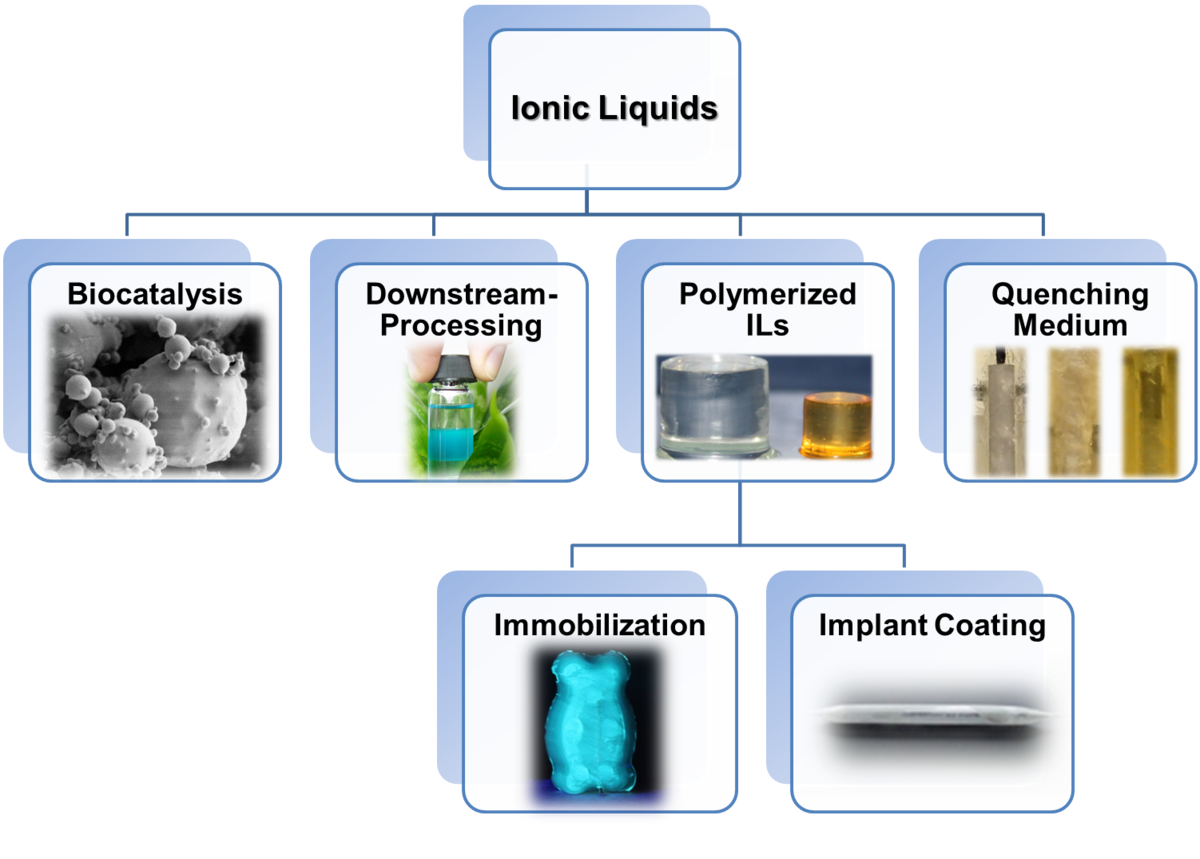- Großeheilmann, J.; Bandomir, J.; Kragl U., Preparation of Poly(ionic liquid)s-supported Recyclable Organocatalysts for the Asymmetric Nitroaldol (HENRY) Reaction. Chem. - Eur. J., 2015, 21 (25), 18957-18960.
- Bandomir, J.; Schulz, A.; Taguchi, S.; Schmitt, L.; Ohno, H.; Sternberg, K.; Schmitz, K. P.; Kragl, U., Synthesis and characterization of polymerized ionic liquids: mechanical and thermal properties of a novel type of hydrogels. Macromol. Chem. Phys., 2014, 215 (8), 716-724.
- Dreyer, S.; Kragl, U., Ionic liquids for aqueous two‐phase extraction and stabilization of enzymes. Biotechnol. Bioeng., 2008, 99 (6), 1416-1424.
- Ludwig, R.; Kragl, U., Do we understand the volatility of ionic liquids? Angew. Chem. Int. Ed., 2007, 46 (35), 6582-6584.
- Kragl, U.; Eckstein, M.; Kaftzik, N., Enzyme catalysis in ionic liquids. Curr. Opin. Biotechnol., 2002, 13 (6), 565-571.
A major field of research in the past years is the use of ionic liquids. ILs are organic salts with unusually low melting points that are significantly below 100 °C. In addition to the basic understanding of the special properties of ILs, new fields of applications are to be developed. The combination of ILs and biocatalysis was always the focus of our research. Their extraordinary properties allow a special combination of solutes dissolved therein, e.g. for the stabilization of enzymes or as a selective extracting agent (Org. Proc. Res. Dev., 2002, 6 (4), pp 553–557). Within the BMBF strategy process biotechnology 2020+, the applicability of IL-based thermomorphic solvent systems for biocatalytic reactions is currently under investigation, which can significantly simplify the downstream processing (Chem. Ing. Tech., 2014, 86 (9), p. 1523).
In technical processes, the transfer from an organic solvent to an ionic solvent can lead to remarkable improvements. Since ionic liquids are charged substances, nanofiltration is a suitable separation method to separate a low-volatile product from an ionic liquid (Chem. Eng. Technol., 2003, 26: 1166–1168). The huge potential of using nanofiltration with ionic liquids is increasingly important when other separation methods are not applicable and this method can also be used for purification and recovery of ILs.
The properties and new applications of polymerized ionic liquids (PILs) have been a further research area of the working group since the last years. Within the REMEDIS-network research project, a local-drug delivery (LDD)-system based on PILs was developed in cooperation with the IBMT at Rostock University. In addition to the characterization of drug release, the development of novel tissue-like systems in order to produce artificial vessels is also beeing developed (RSC Adv., 2015, 5, 11604-11610). This work is currently being continued within the Response-network research project, focusing on both the controlled and the stimulus-responsive release of drugs.
PILs have been investigated for the immobilization of catalysts as a new field of application due to the excellent mechanical and chemical stability of them (Chem. Eur. J., 2015, 21, 18957–1896).
Another interesting field of application is the use of ILs as an ideal quench medium in the heat treatment of metallic materials to ensure a rapid and uniform quenching (HTM, J. Heat Treat. Mater., 2015, 70, (2), pp. 73-80).

